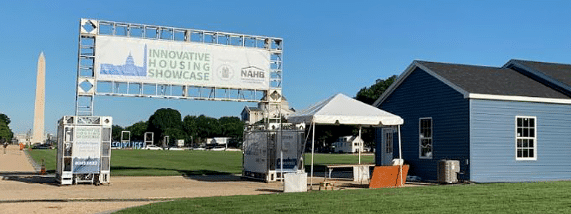(This is the first weekly op-ed column from our new editor, longtime real estate and mortgage industry journalist Phil Hall.)
A few years ago, I arrived home from work on a July evening and found a bright yellow square-shaped envelope in my mailbox. In handling the envelope, I could tell that it contained a card, but this confused me since my birthday was several months away and there was no holiday or personal anniversary at the time that would inspire anyone to send me a card.
Alas, no one was thinking of me. In checking the envelope, I discovered that its delivery was not destined for me, but instead it was meant for Mrs. Rose Tibbett. While it was not uncommon for me to receive mail that was meant for a neighbor’s mailbox, Mrs. Tibbett did not live on my street, nor was she anywhere in the Connecticut town where I resided – she lived in New South Wales, Australia.
Not wanting to delay Mrs. Tibbett’s receipt of mail-delivered felicitations, I took the card to the nearest mailbox and sent it off on what I assumed would be a speedy trip Down Under. Imagine my surprise when two days later the card for Mrs. Tibbett was back in my mailbox. Believe me, I’ve been called many things in my lifetime – but my postal carrier seemed to insist on calling me Mrs. Rose Tibbett.
Clearly, my post office’s mail sorting team did not bother to learn from their error and opted to make the same mistake twice. But truth be told, the local post office was maintaining a sorry tradition of the federal government in repeating mistakes without learning from their errors.
Last month, the U.S. Department of Housing and Urban Development (HUD) happily announced it was conducting a third go-round of an error that is not helping to solve the problem it was intended to address. From June 9-11, HUD is hosting the 2023 edition of its Innovative Housing Showcase on the National Mall in Washington, D.C.
“The Showcase is a public event to raise awareness of innovative and affordable housing designs and technologies that have the potential to increase housing supply, lower the cost of construction, increase energy efficiency and resilience, and reduce housing expenses for owners and renters,” said a HUD press release, predicting that over “2,500 people, including policymakers, housing industry representatives, media, and the general public, are expected to attend. There will be more than a dozen exhibits, including full-sized prototype homes, displaying innovative building technologies that address affordability, resilience, and the future of housing.”
The first Innovative Housing Showcase took place June 1-5, 2019, and at the time HUD under the leadership of Dr. Ben Carson envisioned this event as a means to highlight “innovative technologies that create affordable and resilient housing to help address the nation’s housing challenges.” A press overview from that event noted how from “mobile homes and manufactured homes to containers fitted for housing, the exhibitors displayed their years of experience in the field of affordable, innovative construction.”
The Innovative Housing Showcase was not held in 2020 and 2021 due to the Covid-19 pandemic, but it returned in June 2022, this time with Marcia Fudge as HUD Secretary. Not unlike her Trump administration predecessor, Fudge was fixated on the construction of the housing prototypes on display.
“We just can’t continue to build the houses we grew up in,” she said in a Bloomberg interview. “These houses are more efficient, more resilient. But the other thing is, we need so much new housing. These can be built quickly, installed quickly. They are at a great cost point. And so it is a big part of the solution.”
Unfortunately, Fudge got it wrong. The same Bloomberg article quoted Samuel Landy, president and CEO of the manufactured housing developer UMH Properties, who admitted where the problem rested.
“There’s got to be a solution to local zoning,” Landy said. “Each municipality receives money from the state and federal government. So it shouldn’t be such a home-rule situation, that the people who live in a town can say, ‘Nobody else is moving into my town.’ You need regional planning, and you need ways to get affordable housing approved.”
Last year, I wrote a series called “The Crisis in Housing” for the Benzinga financial news site and Landy’s observation was repeatedly affirmed. Jake Clopton, president of the Chicago-based commercial mortgage brokerage Clopton Capital, noted that it didn’t matter if the property was made from 3D printing, bricks, wood or straw – if local governments refused to flash a green light on projects, nothing was going to be built, no matter how fancy-shmancy the construction process could be.
“It’s difficult to get approvals,” he explained. “I’ve got this one manufactured housing developer in Florida who has been trying to get permits for a year. I’ve had some guys tell me it’s taking longer to get approvals at the local government level.”
Dr. Anthony B. Sanders, chief economist at Artesia Economics and former head of asset-backed and mortgage-backed securities research at Deutsche Bank AG, was in agreement.
“There are a lot of municipal zoning policies about where you can and cannot build multifamily developments, what can be built and how much has to be set aside for below market rate units,” he said. “If you go to various cities like Los Angeles, there is the NIMBY model — not in my backyard. Nobody wants Section 8 housing for the lower-income households to be near them, so they actually prohibit construction of multifamily housing in certain areas. And this is occurring all across the country.”
Now, I am interested in housing construction technology – especially 3D solutions – and I have been focused on the creation of cost- and energy-efficient housing solutions for years. The problem, as I see it, is pretending HUD’s Innovative Housing Showcase is a strategy to fix the seemingly endless shortage involving affordable homeownership and affordable rental housing.
The problem here is not what the house is made from – that was never the issue. The problem is having local authorities constantly making obstacles that prevent the creation and proliferation of affordable solutions to housing needs. Successive presidential administrations never addressed that obstacle, which is still holding up much-needed housing.
Mercifully, my local post office learned from its mistakes – I never received Mrs. Tibbett’s card after putting it back into the mail the second time. Perhaps HUD will finally learn from its third Innovative Housing Showcase and admit why there a lack of affordable residences. The upcoming Showcase might be a lot of fun, but it doesn’t solve a problem that has been with us for too long.
Phil Hall is the editor of Weekly Real Estate News. His writing has been published in the New York Times, New York Daily News, Wired, The Hill’s Congress Blog and The Jerusalem Post. He is also the former editor of MortgageOrb, Secondary Market Executive and Servicing Management, and the former managing editor of National Mortgage Professional.
Photo courtesy of HUD















